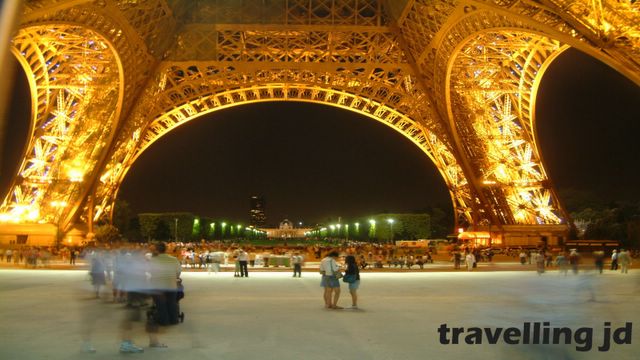
February 13, 2006
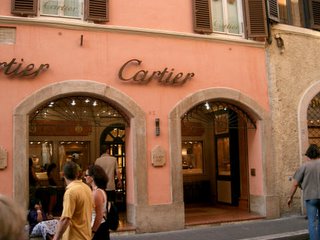
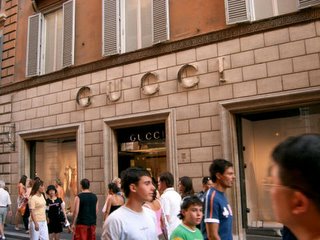
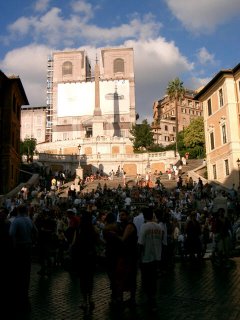
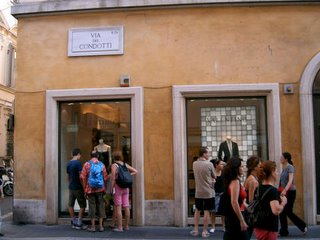
Welcome to one of the most famous streets in Rome.Via Condotti has very old origins: in Roman times it was one of the streets that crossed the ancient Via Flaminia and enabled people who crossed the Tiber to flow towards the Pincio hill. On the Pincio hill, Lucullo, the Roman leader famous from having brought to Rome the culture and oriental splendor from Geece, decided to build his villa after having defeated Mitridate in Asia Minor.Via Condotti originally must have been the entrance to Lucullo's villa and remained during the Medioeval times a country road. At the onset of 1500 it was called Via Trinitatis, taking the name from the church at the end of the street. The use of the term Condotti began back at the beginning of 1500, when, underneath the road, pipelines were placed in order to bring the famous Acqua Vergine (Vergin Water) to this part of the city.During 1600 the most important buildings were created, such as the Convent of the Trinitari Castigliani at the top of the street, commissioned by the king of Spain, Philip V. During the 18th century Palazzo Torlonia (former Palazzo Nunez) was built. In this building Napoleon's family lived at the onset of 1800. In the same period the Palazzo dell'Ordine di Malta (Order of Malta Palace) was erected. However the final touch and true asset to the street was build during 1700 when the construction of the Spanish Steps, an authentic architectural back-drop, began.From 1870 the street has pretty much remained the same as it was originally designed, when Rome became the capital of Italy and this area was designed to be occupied by banks and state administrative offices.Since the beginnig of 1700 the habit of meeting in Via Condotti's cafes and at the Spanish Steps has not altered in the slightest. The names of those who met in Via Condotti are very well know and distinguished such as: Sthendal, Byron, Shelley, Goethe and D'Annunzio.Carlo Goldoni, the famous playwriter, lived on via Condotti from 1758 till 1759.Guglielmo Marconi, inventor of the radio, lived in Palazzo Maruscelli in 11, via Condotti until the time of his death in 1937.A plague still stands today to indicate where one of the most famous Italian poets, Giacomo Leopardi lived (81, via Condotti). Well known is the atrium located in Palazzo Negri-Arnoldi (21, via Condotti) and the courtyard of Palazzo Caffarelli that dates back to the 18th century.Caffé Greco is perhaps the most famous cafè in the capital; estabilished in 1760 by a Greek man, remains today one of the places where, politicians, artist and writers meet. (from shoppingitaly.it)
- clubs -
- blogs -
- travel tools - - travel blogs - - travel links - - france - - air - -newspapers- -Travel Magazines- - cameras & things - - sports - - financials - - archives -
Glencoe District Lions
blamblog
meredith
Ice Queen
Government of Canada Consular Affairs-Warnings and other useful info
USA Bureau of Consular Affairs- Travel Information
Southwest Middlesex
Weather Underground
World Time
Travel Maps
Restroom Ratings
Translation
Currency Calculator
Slow Travel
Top Travel Blogs
TravelBlog
Vagabonding
Aircanada Vacations
Bel Air Travel
Book It For Less
Commodore Travel Oshawa
Elderhostel
Exit Travel
Flight Centre
Itravel 2000
LastMinuteClub
Renaissance Travel
RedTag Vacations
Sears Travel
Travel Discounters
Vacations to Go -Cruises
Bonjour Paris
TVG
The BUS
The Bus
Apt.Rental La Clusaz
Ski Pass Reservation
Ecole de Ski Francais
Tourist Office of La Clusaz
National Tourist Office-France
Hotel Reservations-France
Air Transat
Skyservice
SYDNEY MORNING HERALD
CHICAGO TRIBUNE
Detroit Free Press
The Globe and Mail
The Guardian
The London Free Press
MAIL & GUARDIAN S.AFR.
Montreal Gazette
Cape Times,Cape Town
Los Angeles Times
LE MONDE
FIGARO
LE PARISIEN
La Repubblica
Toronto Sun
Washington Post
London Times Online
Have Children Will Travel
Connected Traveler
Journey Woman
Ticked-Off Tourist
TimeSharer Magazine
Transitions Abroad
Travel and Leisure Mag.
Travel With A Challenge
digital camera reviews
Sharper Image
PGA
NBA
tsx
November 2004
December 2004
January 2005
February 2005
March 2005
April 2005
May 2005
June 2005
July 2005
August 2005
September 2005
October 2005
November 2005
December 2005
January 2006
February 2006
March 2006
April 2006
May 2006
June 2006
July 2006
August 2006
September 2006
October 2006
November 2006
March 2009
